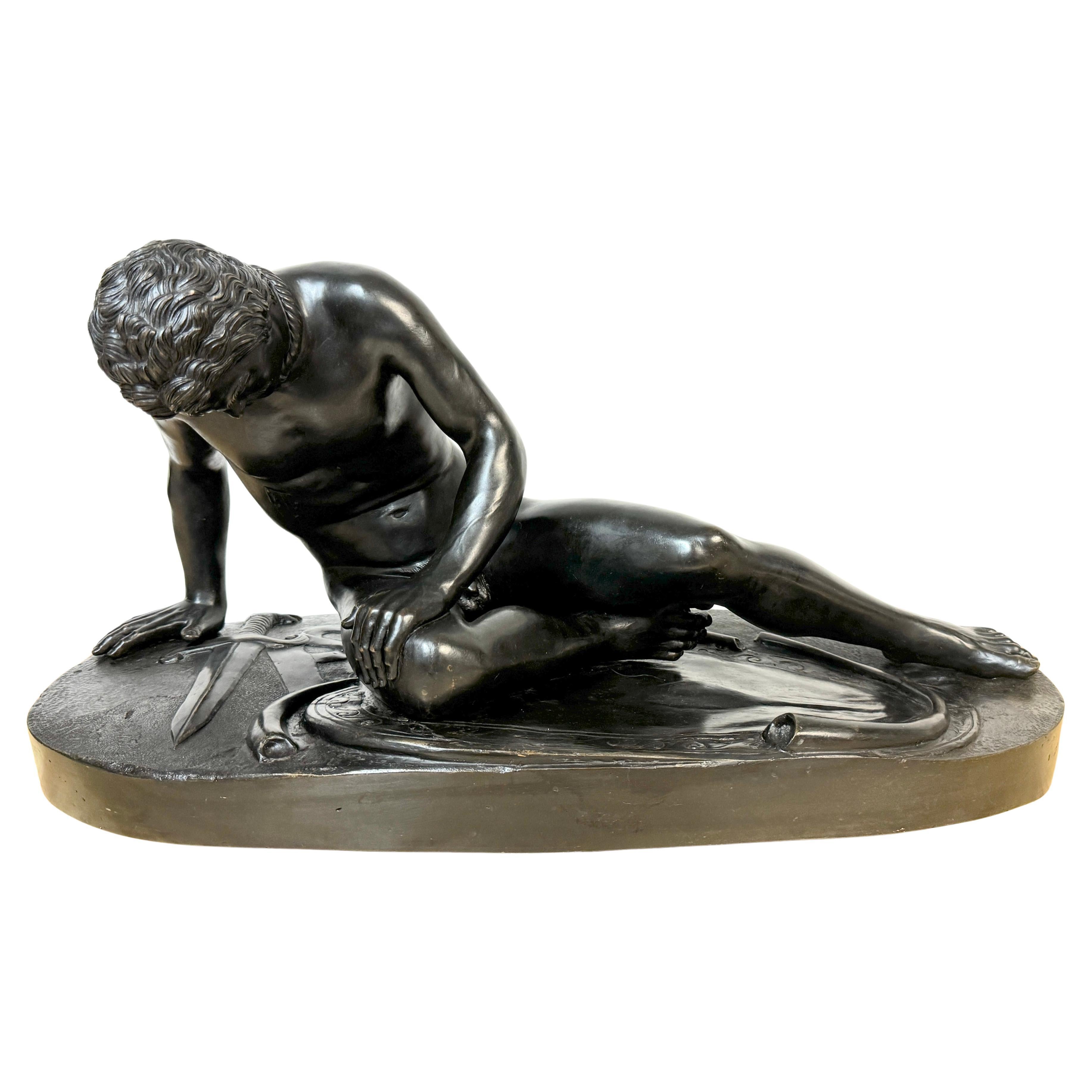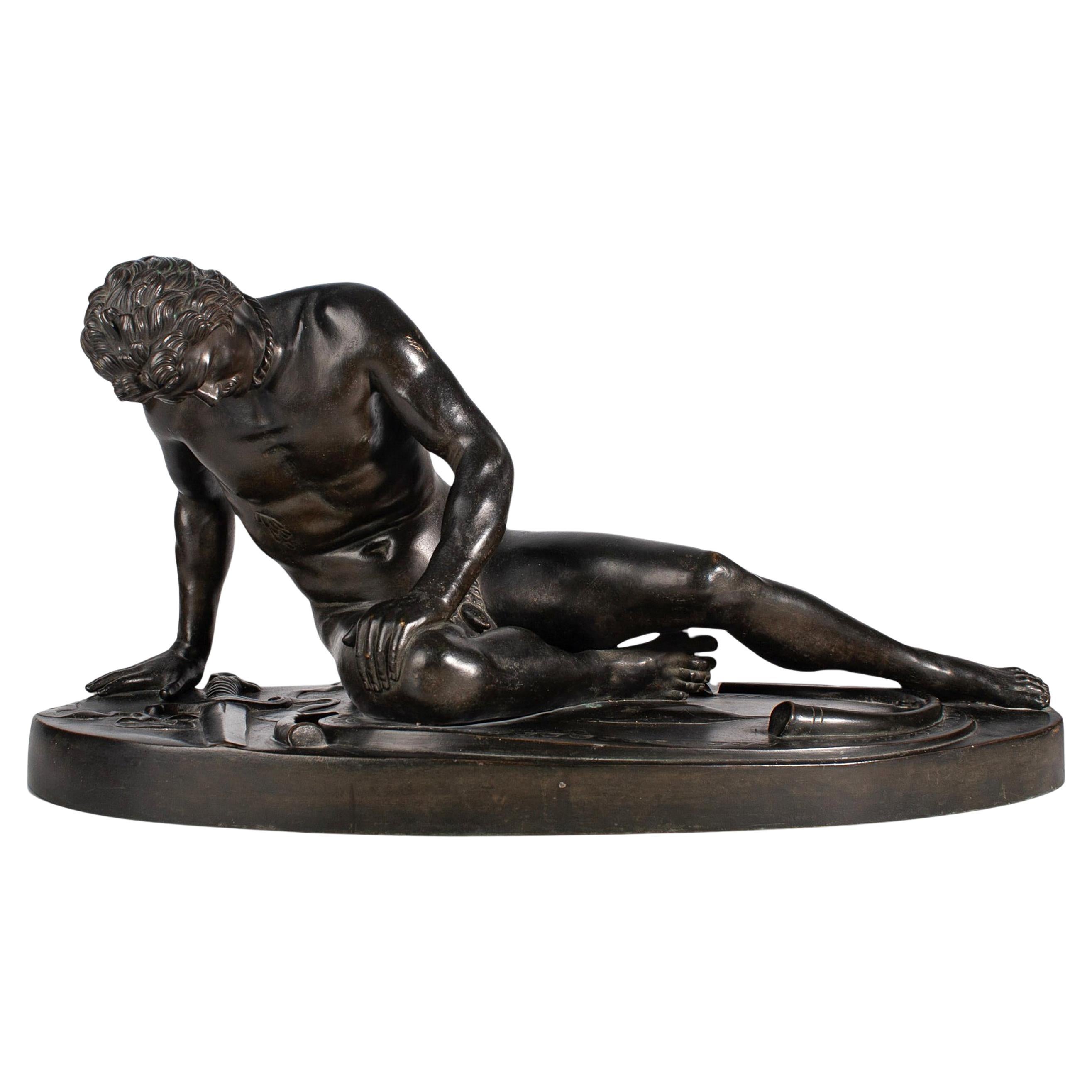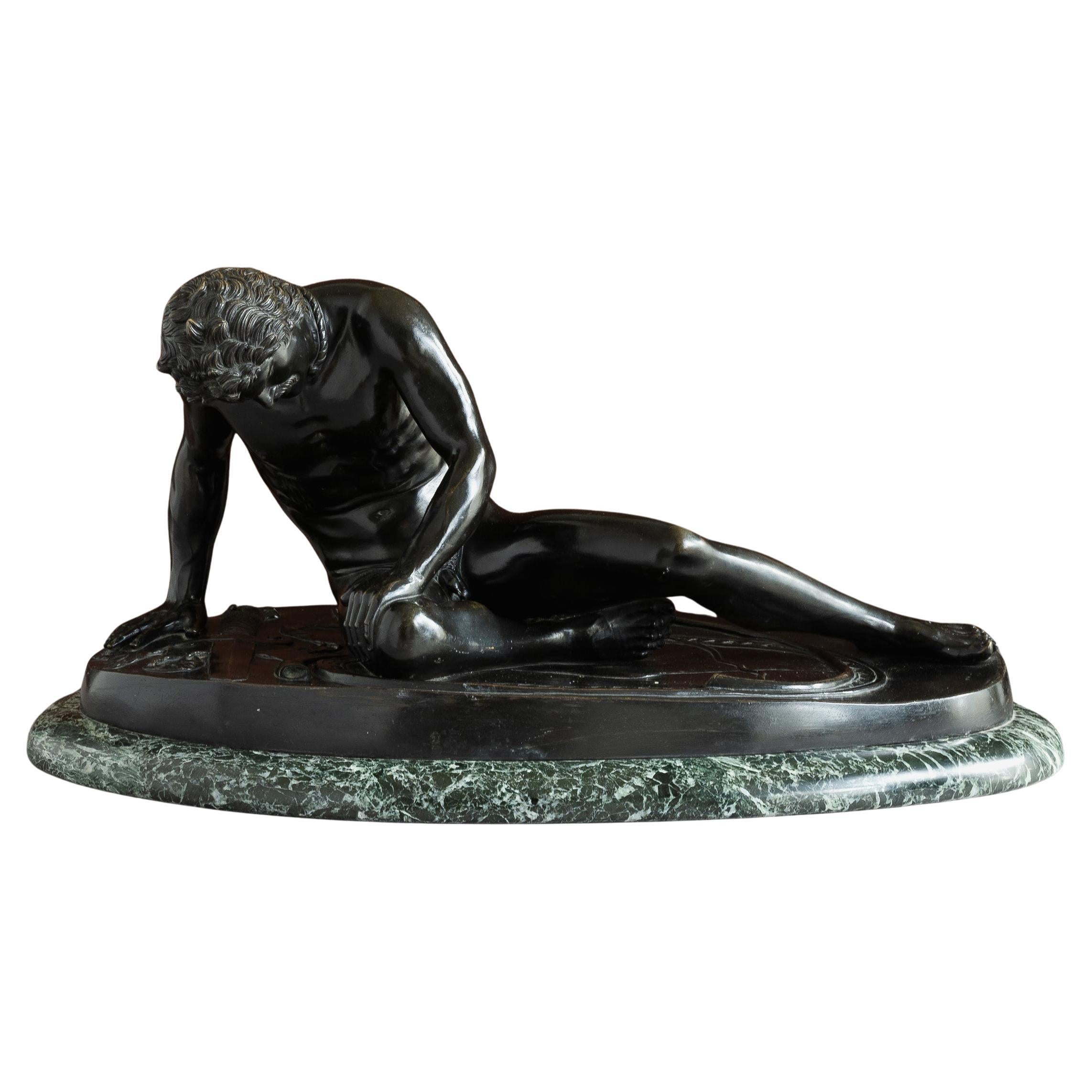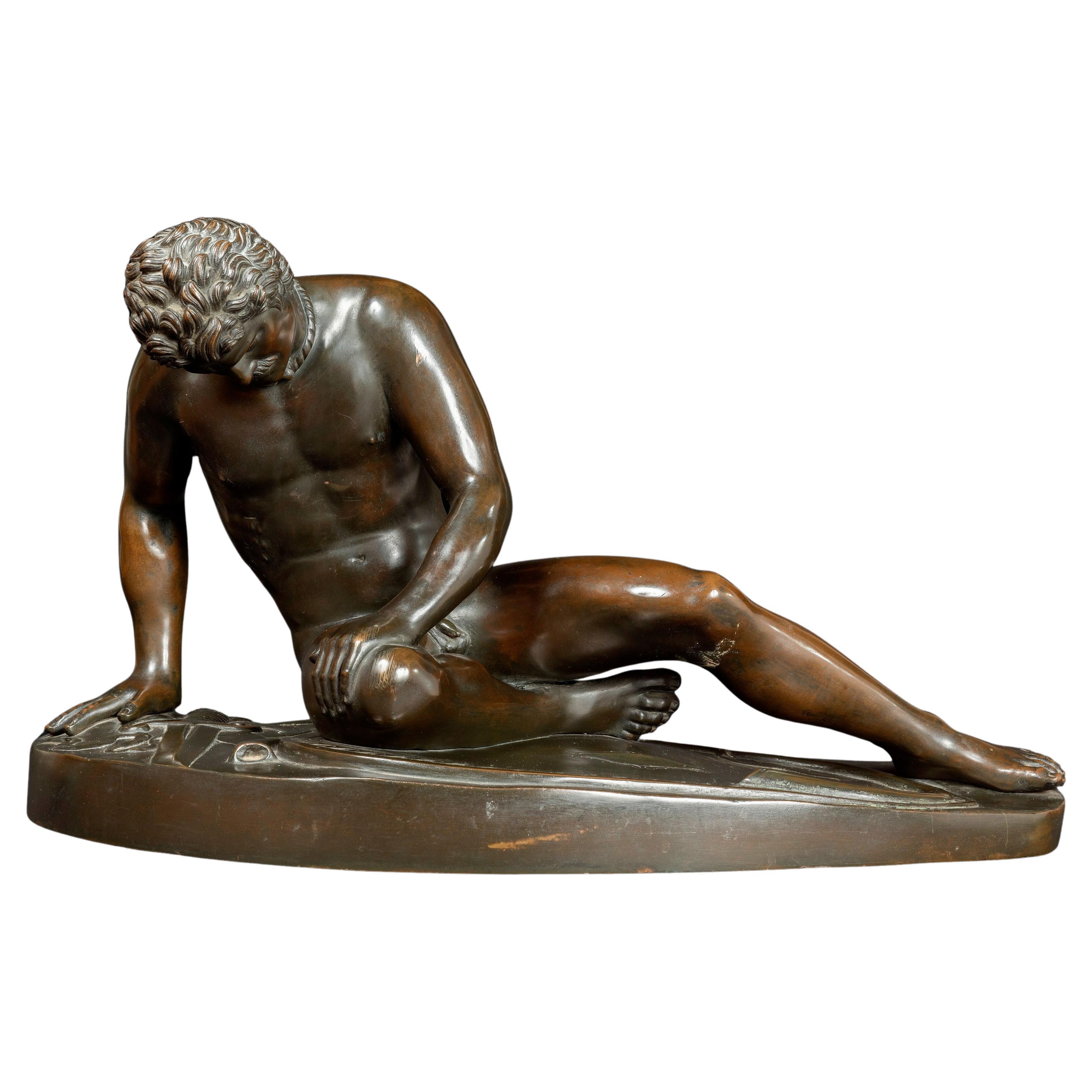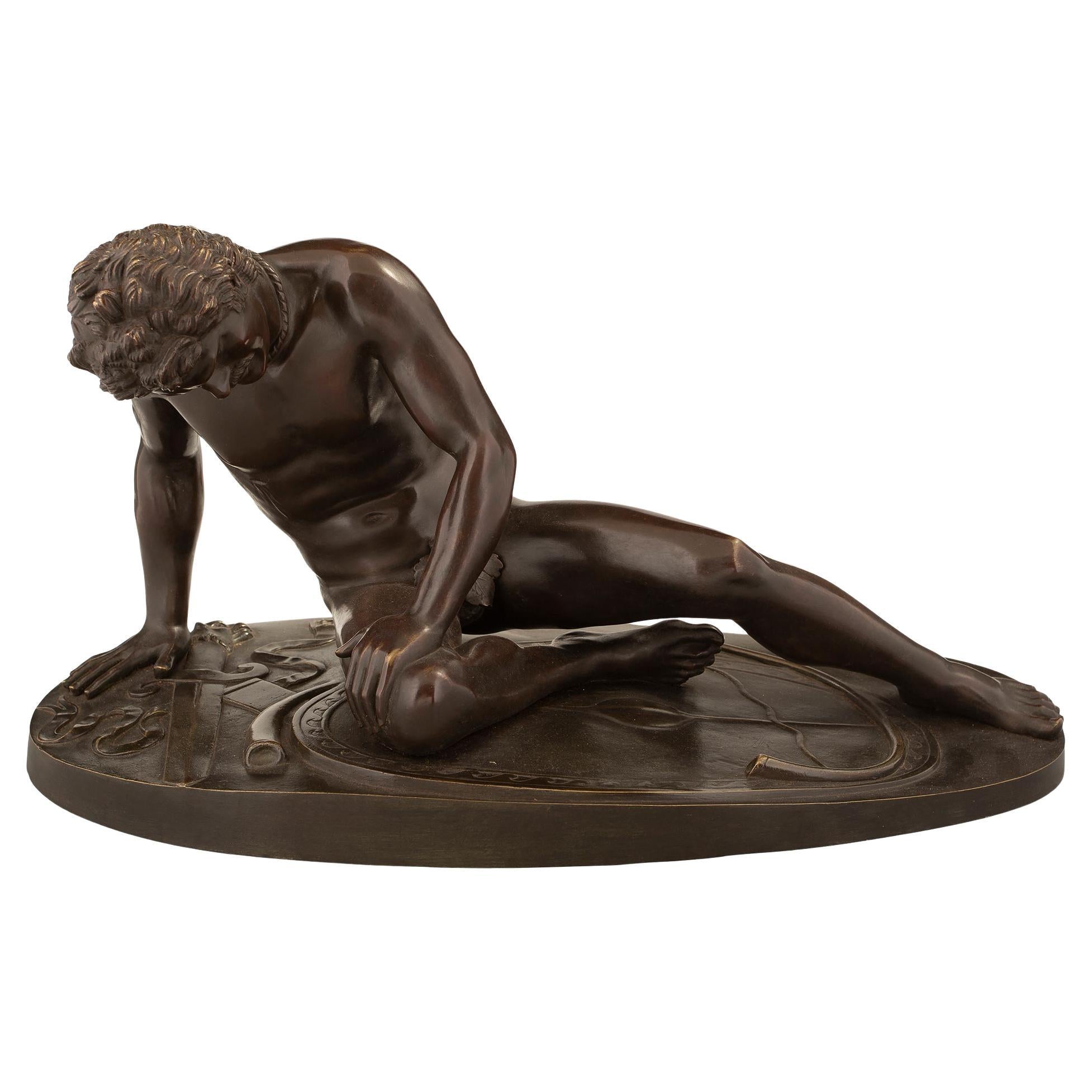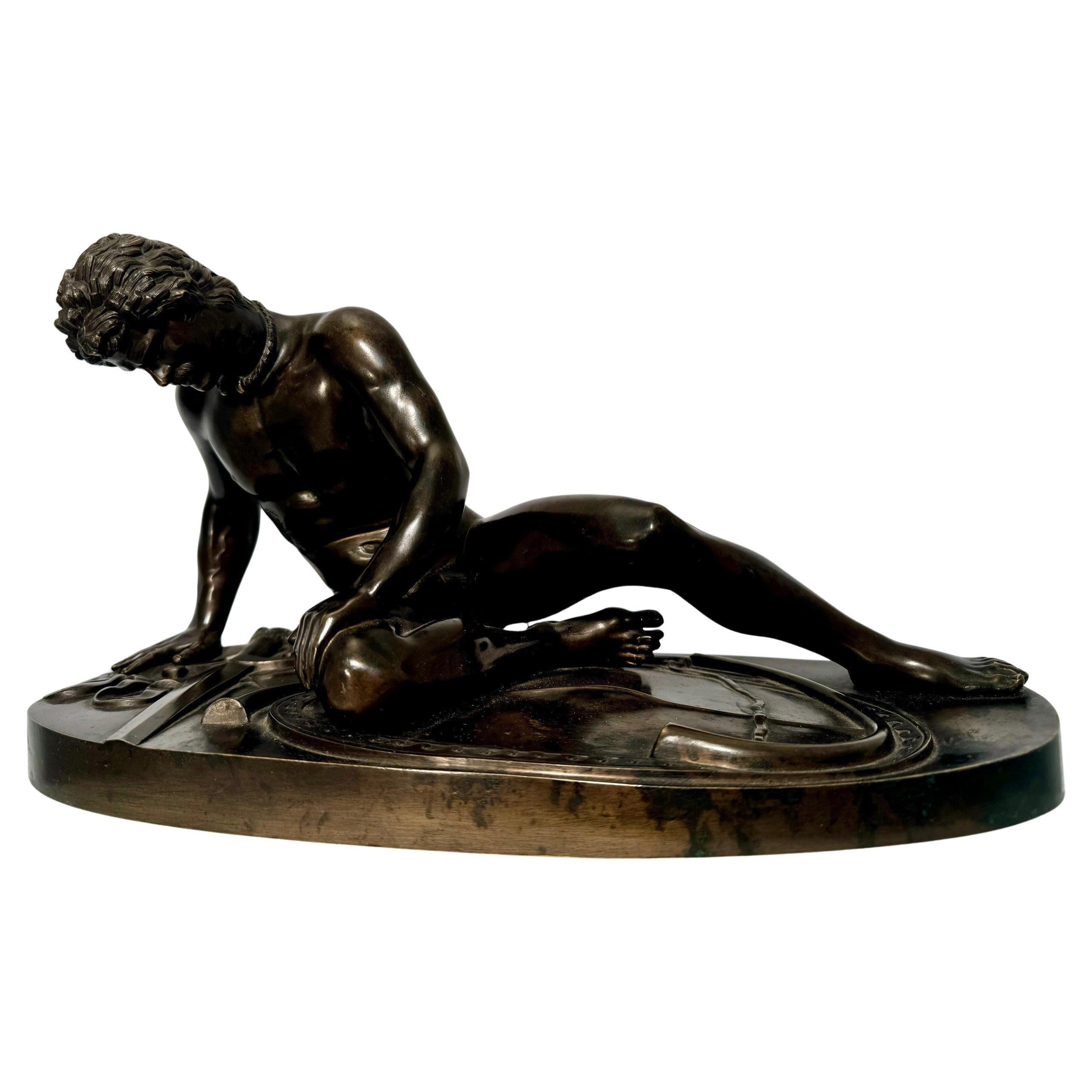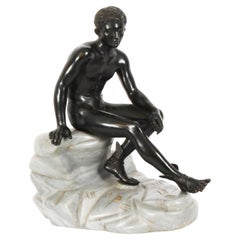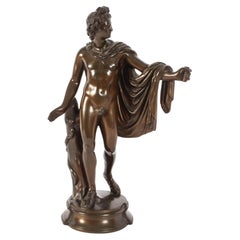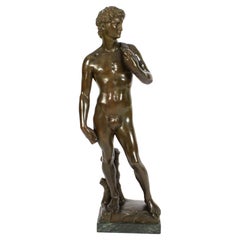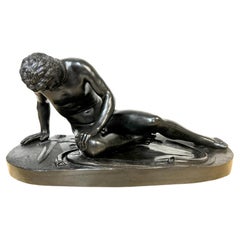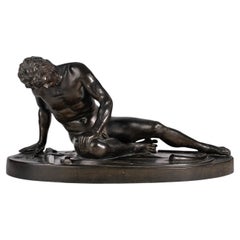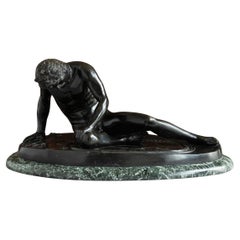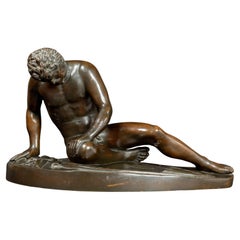Items Similar to Antique Bronze Sculpture of the Dying Gaul by B Boschetti Rome, 19th Century
Video Loading
Want more images or videos?
Request additional images or videos from the seller
1 of 20
Antique Bronze Sculpture of the Dying Gaul by B Boschetti Rome, 19th Century
$5,035.76
£3,650
€4,305.83
CA$6,926.61
A$7,699.35
CHF 4,035.84
MX$94,027.74
NOK 50,385.09
SEK 47,402.97
DKK 32,137.45
About the Item
This is a truly magnificent antique Italian Grand Tour figural golden patinated bronze sculpture depicting a wounded gladiator known as "The Dying Gaul", and signed B Boschetti, Roma, circa 1830 in date.
This striking classical sculpture is after the original antique Roman marble sculpture found in the Capitoline Museum in the early 17th Century, which is itself a copy of an ancient Hellenistic bronze sculpture commissioned by Attalus of Pergamon in 230-220 BC to celebrate his victory over the Galatians.
This exquisitely executed bronze sculpture depicts the wounded naked dying gladiator with remarkable realism and pathos. He is beautifully featured as a Celtic warrior with curly hairstyle and has a characteristic band of twisted metal around his neck. He lies on his fallen shield while his sword lies beside him on the right-hand side and his head is looking downward in dignified sorrow.
He is raised on an antico rosso oval plinth on bun feet and is signed B Boschetti Roma, on one end of the bronze.
The attention to detail throughout this piece is second to none.
Add a classical dimension to your home with this captivating Italian Grand Tour sculpture.
Condition:
In really excellent condition, please see photos for confirmation..
Dimensions in cm:
height 23 x width 38 x depth 20
Dimensions in inches:
height 9 inches x width 1 foot, 3 inches x depth 8 inches
Benedetto Boschetti
In the early 19th Century Benedetto Boschetti fed the growing demand for high quality works of art with an antique theme created by an influx of grand tourists, many of whom were English. Little is known about his life, but he is known to have worked out of his workshops in the centre of Rome where he produced a large number of classically inspired objects ranging from bronzes to tabletops and mosaics. Active between 1820-1870, the Boschetti workshop exhibited at the Crystal Palace Exhibition in 1851. The workshop was renowned for the exceptional quality of its copies after the 'Antique', mainly in marble and bronze.
First recorded in the Ludovisi Collection in 1623, the antique marble known as 'The Dying Gaul' was acquired for the Capitoline Museums by Pope Clement XII, before being ceded to the French in 1797. The sculpture arrived in Paris in a triumphal procession and was housed in the Musée Central des Arts. After Napoleon's defeat at Waterloo in 1815, it was returned to the Capitoline Museums, where its fame was such that it was displayed in a dedicated room named after it. The subject was long interpreted as a Gladiator until late 19th-century scholarship identified the poignant figure as a wounded Galatian, whose army invaded the Hellenistic kingdom of Pergamon in the third century AD. Since the marble's discovery, its popularity has spawned numerous reductions in bronze, marble and alabaster.
- Creator:Benedetto Boschetti (Maker)
- Dimensions:Height: 9.06 in (23 cm)Width: 14.97 in (38 cm)Depth: 7.88 in (20 cm)
- Materials and Techniques:
- Place of Origin:
- Period:
- Date of Manufacture:circa 1830
- Condition:
- Seller Location:London, GB
- Reference Number:Seller: A31331stDibs: LU950632742832
About the Seller
5.0
Platinum Seller
Premium sellers with a 4.7+ rating and 24-hour response times
Established in 1983
1stDibs seller since 2012
1,388 sales on 1stDibs
Typical response time: <1 hour
Associations
LAPADA - The Association of Arts & Antiques Dealers
- ShippingRetrieving quote...Shipping from: London, United Kingdom
- Return Policy
Authenticity Guarantee
In the unlikely event there’s an issue with an item’s authenticity, contact us within 1 year for a full refund. DetailsMoney-Back Guarantee
If your item is not as described, is damaged in transit, or does not arrive, contact us within 7 days for a full refund. Details24-Hour Cancellation
You have a 24-hour grace period in which to reconsider your purchase, with no questions asked.Vetted Professional Sellers
Our world-class sellers must adhere to strict standards for service and quality, maintaining the integrity of our listings.Price-Match Guarantee
If you find that a seller listed the same item for a lower price elsewhere, we’ll match it.Trusted Global Delivery
Our best-in-class carrier network provides specialized shipping options worldwide, including custom delivery.More From This Seller
View AllAntique Italian Bronze Sculpture Herme Naples Italy 19thC
Located in London, GB
This is a beautifully detailed antique Italian Grand Tour bronze sculpture of Hermes, dating from Circa 1880.
Hermes is cast after the original held at the Museo Nazionale in Naples...
Category
Antique 1880s Figurative Sculptures
Materials
Bronze
Antique Large Italian Grand Tour Bronze Sculpture Mercury Hermes 19thCentury
Located in London, GB
This is a beautifully detailed antique Italian Grand Tour School bronze figural sculpture of Hermes, dating from Circa 1880.
Mercury is cast after the original held at the Museo Naz...
Category
Antique 1880s Figurative Sculptures
Materials
Bronze
Antique Victorian Bronze Sculpture of Greek God Apollo 19th Century
Located in London, GB
This is a truly magnificent antique Victorian patinated bronze sculpture of the famous Greek God Apollo, modelled upon a shaped circular socle, inscribed monogram 'NF' and numbered 2...
Category
Antique 1860s English Victorian Figurative Sculptures
Materials
Bronze
Antique Monumental Grand Tour Bronze of Michelangelo David 19th Century
Located in London, GB
This is an elegant monumental Grand Tour bronze sculpture of Michelangelo's David, circa 1880 in date.
The full-length portrait statue is of David, the 14ft marble statue depicts the Biblical hero David, represented as a standing male nude, David looks tense and ready for battle after he has made the decision to fight Goliath, but, before the battle has actually taken place. His brow is drawn, his neck tense, and the veins bulge out of his lowered right hand and holding his slingshot over his shoulder.
This impressive scuplture is 107cm (3ft 6" ) tall and weighs over 36kgs (79lbs).
This high quality hot cast solid bronze was produced using the traditional 'lost wax' process.
The attention to detail of this sculpture is absolutely fantastic.
Condition:
In really excellent condition, please see photos for confirmation.
Dimensions in cm:
Height 107 x Width 41 x Depth 24.5
Weight 36.3 kg
Dimensions in inches:
Height 3 foot, 6 inches x Width 1 foot, 4 inches x Depth 10 inches
Weight 80.0 lbs
Michelangelo's David
This astonishing Renaissance sculpture was created between 1501 and 1504. It is a 14ft marble statue depicting the Biblical hero David, represented as a standing male nude. Originally commissioned by the Opera del Duomo for the Cathedral of Florence, it was meant to be one of a series of large statues to be positioned in the niches of the cathedral’s tribunes, way up at about 80mt from the ground. Michelangelo was asked by the consuls of the Board to complete an unfinished project begun in 1464 by Agostino di Duccio and later carried on by Antonio Rossellino in 1475. Both sculptors had in the end rejected an enormous block of marble due to the presence of too many “taroli”, or imperfections, which may have threatened the stability of such a huge statue...
Category
Antique 1880s Figurative Sculptures
Materials
Bronze
Antique French Grand Tour Ormolu Bronze Model of Borghese Gladiator
Located in London, GB
This is a wonderful antique French Grand Tour classical bronze model of the Borghese Gladiator, circa 1880 in date.
The well patinated bronze on a rectangular bronze base inscribed ...
Category
Antique 1880s French Figurative Sculptures
Materials
Bronze
Antique Art Deco Bronze Figure by Maurice Guiraud-Rivière 20th Century
By Maurice Guiraud-Rivière
Located in London, GB
A large fine Art Deco patinated bronze figure of "The Riverman" by Maurice Guiraud-Rivière (French, 1881-1947), circa 1920 in date.
This powerful sculpture is modelled and cast a...
Category
20th Century French Art Deco Figurative Sculptures
Materials
Bronze
You May Also Like
Large Italian Grand Tour Bronze Sculpture "Dying Galata" /Dying Gaul, C. 1875
Located in West Palm Beach, FL
Large Italian Grand Tour Bronze Sculpture "Dying Galata"/Dying Gaul, C. 1875, Attributed to Naples Foundry
A remarkable large Italian Grand Tour bronze sculpture titled "Dying Galata" or "Dying Gaul," dating circa 1875 and attributed to the renowned Naples Foundry. This exquisite piece, an expertly cast bronze, retains its original black-brown patina and boasts a substantial size, standing 12 inches high, 26.5 inches wide, and 13.5 inches deep. It is a distinguished example of the iconic Grand Tour sculptures, which were popular souvenirs for affluent travelers during the 19th century.
The sculpture is a faithful rendition of the ancient Roman marble statue "The Dying Gaul," also known as "The Dying Galatian" or "The Dying Gladiator." The original marble, now housed in the Capitoline Museums in Rome, is a Roman copy of a lost Greek bronze sculpture...
Category
Antique 19th Century Italian Grand Tour Figurative Sculptures
Materials
Bronze
Mid-19th Century Grand Tour Bronze Figurative Sculpture 'The Dying Gaul', Italy
Located in North Miami, FL
Mid-19th Century Grand Tour Bronze Figurative Sculpture 'The Dying Gaul', Italy
By: unknown
Material: bronze, copper, metal
Technique: cast, molded, polished, metalwork, patinated
D...
Category
Antique 1850s Italian Grand Tour Figurative Sculptures
Materials
Metal, Bronze, Copper
Antique Bronze Figure of The Dying Gaul
Located in London, GB
A bronze figure of the dying Gaul after the Antique, on verde marble base, Italian, nineteenth century.
Dimensions: 30.5cm (12") High, 35cm (13¾") Wide, 65cm (25½") Long, 13.5cm (5¼...
Category
Antique 19th Century Italian Classical Greek Figurative Sculptures
Materials
Marble, Bronze
"The Dying Gaul": Bronze sculpture 'Gala Morente' cast by CHIURAZZI NAPOLI
Located in Ixelles, BE
The Dying Gaul.
- Description of the Work:
A Celtic warrior lies nude, half-reclining on his shield, his body contorted by pain. His right hand touches the ground while his face, m...
Category
Antique 19th Century Hellenistic Figurative Sculptures
Materials
Bronze
Italian 19th Century Patinated Statue of ‘The Dying Gaul’
Located in West Palm Beach, FL
A handsome Italian 19th century patinated statue of 'The Dying Gaul'. The statue is raised by an oval shaped terrain like designed base. The fallen gladiato...
Category
Antique 19th Century Italian Figurative Sculptures
Materials
Bronze
Grand Tour bronze figure of “The Dying Gaul”, After The Antique
Located in Montreal, QC
A late 19th century Grand Tour bronze figure of “The Dying Gaul”, after the antique. The Dying Gaul depicts a warrior in his final moments, next to his shield and sword, his face contorted in pain just before he collapses from the mortal wound to his chest The original marble figure, which is in the Capitoline museum in Rome is thought to be a Roman copy of a Greek sculpture in Bronze. As an image of a vanquished enemy, the sculpture embodies courage in defeat, self-possession in the face of death, and the recognition of nobility in an alien race.
“The Dying Gaul” was found in Rome with another ancient marble...
Category
Antique Late 19th Century Italian Classical Greek Figurative Sculptures
Materials
Bronze
More Ways To Browse
The Crystal Palace
Twisted Metal Sculpture
Crystal Palace Antique
Antique Long Sword
Sword Display
Mosaic House
Bronze Sword Sculpture
Bronze Sculpture 17th Century
Antique Gold Sword
Sword And Shield
Antique Metal Records
Alabaster Sculpture Signed
Hellenistic Gold
Alabaster Head
Antique Italian Swords
Grand Tour Mosaic
Warrior Shield
Roman Foot Sculpture
